How to make moonshine from rye at home
Finding quality alcohol on store shelves is not easy. Making alcohol at home guarantees quality, environmental friendliness and safety.
The article tells how to prepare real men's drinks - rye moonshine and whiskey. You will learn how to germinate rye for malt, whether you need to use yeast, why and how to saccharify rye starch.
Features of rye moonshine
Moonshine made from rye has a bright characteristic taste and aroma.
Aromatic features
At first the aroma may seem harsh. But after standing in the glass for a while, the drink acquires a soft smell of fresh rye bread with a pleasant sourness.
Taste
Moonshine is pleasant to drink, it tastes slightly sweet. Leaves a long aftertaste of rye bread crumb.
On a note. Rye moonshine goes well with kvass, which emphasizes its bready bouquet.
How to make moonshine from rye without yeast
Alcohol made from cereals tastes better than alcohol made from sugar-containing raw materials. It is not difficult to prepare it at home, although this process is multi-step and requires care and precision.
Ingredients
To prepare the drink you will need:
- rye grain - 6.15 kg (0.15 kg for fermentation, 1 kg for malt, 5 kg for mash);
- granulated sugar - 0.06 kg for fermenting;
- water.
Attention! Choose grains without damage or signs of spoilage (dark spots, mold).
Getting malt
The starch contained in the grain is not fermentable.To start the process, you need malt - sprouted cereal grains.
During germination, chemical changes occur in the composition of the seeds and the enzyme diastase is formed, which can dissolve and decompose starch into maltose, one of the sugars that can ferment.
For rye moonshine, malt is prepared on the basis of rye:
- Pour 1 kg of washed rye into a wide basin or pan and pour cold water 4-5 cm above the level of the grains, leave for 7-8 hours.
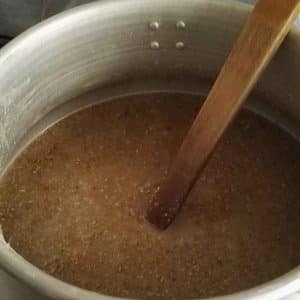
- Remove all floating debris and empty grains, drain the water and repeat the soaking procedure 3 more times.
- Spread the cereal in a thin layer in a wide bowl and cover with damp gauze folded in 4-5 layers.
- Leave the future malt in a cool, dark place, carefully stirring the grains every 10-12 hours.
- Regularly moisten the gauze to prevent the sprouts from drying out, but avoid excessive wetting of the grains.
- Sprout the grains until the sprouts reach a length of 5-6 mm. On average, this takes about a week.
Important! In this way, “green malt” is obtained. It must be used within 3 days, otherwise the enzyme activity will decrease significantly.
Preparation of ferment
To prepare mash without yeast, you will need to ferment it - activate the “wild” yeast located on the surface of the grains.
Manufacturing stages:
- About 150 g of rye is thoroughly washed to remove dust and husks.
- The washed grain is laid out in a layer of 2-3 cm on the bottom of a wide container and filled with cold water 1-1.5 cm above the level of the rye. There is no need to cover the dishes.
- Leave the workpiece in a dark place for a day.
- Add 50-60 g of sugar, mix thoroughly and leave in a warm place for 3-5 days.
Signs of readiness are the appearance of gas bubbles, foam on the surface and a slight smell of fermentation.
On a note! To prevent souring, the finished wade is placed under a water seal.
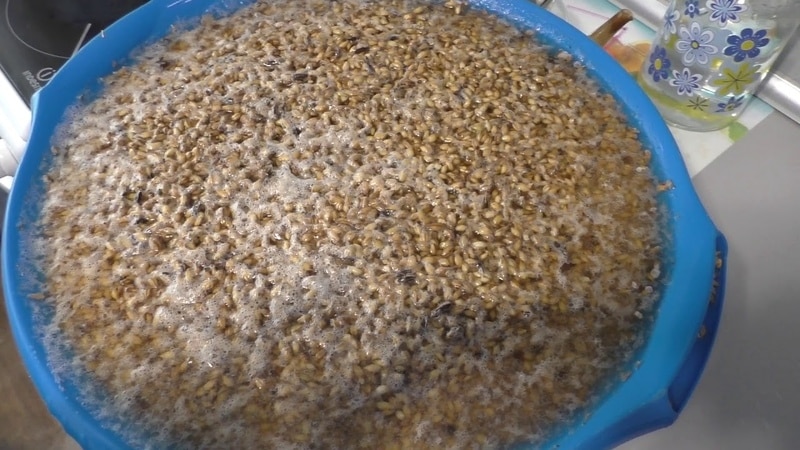
Saccharification
Before brewing, rye starch is converted into sugar (maltose).
Stages of the saccharification process:
- Grind the remaining rye in a blender until it becomes coarse flour.
- Heat 20 liters of water to 48-50 °C.
- The crushed grain is poured into heated water with constant stirring.
- The resulting mass is heated to 58-60 °C and left at this temperature for 15 minutes.
- Add heat and heat the mixture to 62-64 °C, again maintain at this temperature for 15 minutes.
- Then bring the paste to a boil and cook for 1.5-2 hours. Stir the mixture periodically to prevent it from burning.
- Cool the mass to 63-65 °C.
- Grind the previously prepared malt in a blender.
- In a separate container, heat 3 liters of water to 23-25 °C and add crushed malt. Mix thoroughly. The result will be “malt milk”.
- With constant stirring, pour the milk in a thin stream into the boiled rye flour.
- Close the container with a lid and heat to 62-63 °C. The temperature should not rise above 70 °C, otherwise the enzymes will be destroyed and starch saccharification will not occur.
- Wrap the bowl with the mixture in a warm cloth and leave for 2 hours. At the same time, mix the mass every 20-25 minutes.
On a note! To improve the taste of the finished product, use spring or well water.
Fermentation
When all the ingredients are ready, start preparing the mash:
- The warm flour mass after saccharification (wort) is quickly cooled to 23-25 °C by placing the container in a bath of cold water or ice. This will help avoid the development of pathogenic bacteria.
- The cooled liquid is poured into a fermentation vessel, filling it no more than 70-75% in case of violent fermentation and foaming.
- Add rye ferment and mix thoroughly.
- A water seal is installed at the neck of the container to prevent air from entering the fermentation vessel.
- Leave the liquid to ferment in a warm (20-25 °C) dark place. The process lasts from 7 to 14 days depending on the temperature and degree of saccharification. The higher these parameters are, the faster the fermentation will end.
The finished mash stops releasing carbon dioxide, the liquid becomes clear, and sediment falls to the bottom of the container. Fully fermented wort has a bitter taste without any signs of sweetness. Braga, ready for distillation, has a strength of at least 10º.
On a note! A rubber glove is used as a water seal, after first piercing a hole in one of the fingers.
Distillation
Distillation is the most important stage in the preparation of rye moonshine. The taste and aroma of the final product will depend on the quality of distillation.
Attention! To monitor the progress of the process, you need an alcohol meter and a thermometer.
Distillation purifies the product from dangerous impurities formed during fermentation. The main harmful substances in the mash are considered to be methanol, acetaldehydes (“heads”) and fusel oils (“tails”).
First stage
At this stage, insoluble impurities present in the mash are separated and the strength is increased. The process is carried out without separating the fractions. For this:
- Using a tube or short hose, carefully drain the spent mash from the sediment into a clean container.
- Filter the liquid first through several layers of gauze and then through a cotton filter. If filtration is neglected, sediment particles can burn and clog the tubes of the moonshine still.
- The mash is poured into the cube of a moonshine still, heated to a boil and the alcohol is distilled to a content of 3-5% in the stream (which corresponds to a boiling point of 99.5 °C).
Using an alcohol meter, the total strength of raw alcohol is determined, then diluted with water to 19-20º.
On a note! You can clean the raw material with activated carbon before the second distillation. But in the case of preparing rye moonshine to preserve the bready aroma, experienced moonshiners do not recommend doing this.
Second stage
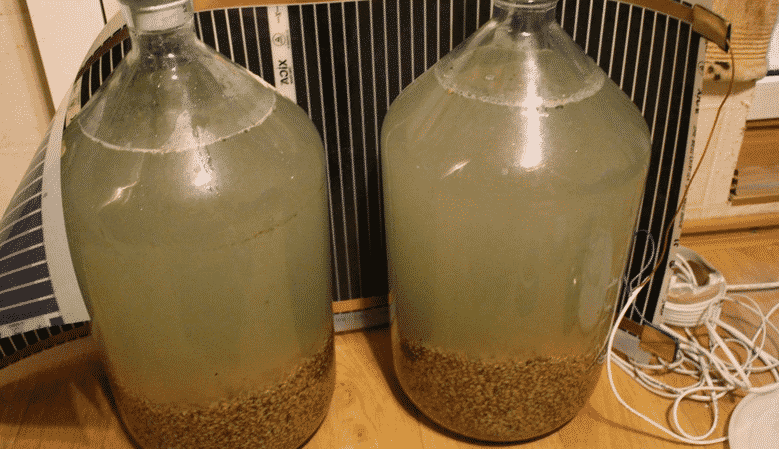
The second distillation (or fractional distillation) is based on the difference in boiling points of the substances resulting from fermentation. When heated, products are first released with a boiling point lower than that of ethanol (“heads” or “pervach”), then the drinking fraction (“body”) and a bottom residue with a high boiling point (“tails”) remains.
Stages of the second distillation:
- The diluted raw alcohol is poured into the still cube and the heating is turned on.
- When the first drops of distillate appear, reduce the heat so that the rate of liquid release is 1-3 drops per second. The selection of “heads” is carried out slowly for better separation from the drinking fraction.
- The distillation of the light fraction is continued until the characteristic unpleasant odor of acetone disappears.
- Change the receiving container, increase the heat to form a thin stream, and expel the main product.
- Finish distillation at a strength of 45-48º in a stream (corresponding to a boiling point of 94-94.3 °C). With further selection, fusel oils end up in the main fraction.
Diluting moonshine
The strength of the product after a properly carried out second distillation ranges from 50 to 60º.To improve the drinking properties of moonshine, it is recommended to dilute it with good (preferably spring) water to a concentration of 38-41º.
After dilution, the drink is poured into glass containers, sealed tightly and left for a week. During this time, the taste and aroma stabilize.
This is interesting:
How to make delicious and simple jam from watermelon rinds.
How to cook lightly salted cucumbers in a bag quickly and tasty.
Product yield
The yield of rye moonshine from mash depends on many factors:
- completeness of starch saccharification;
- fermentation technology (temperature, water seal quality);
- distillation quality;
- moonshine still design.
The theoretical yield of moonshine in terms of a forty-proof product is 880 ml from 1 kg of rye. In practice, this figure may be 10% less.
How to make homemade whiskey from rye moonshine

Rye moonshine prepared according to all the rules is good on its own, but connoisseurs recommend trying to make whiskey using it.
The simplest recipe is to infuse moonshine in an oak barrel. The drink should last from 2 months to a year in the container. The larger the volume of the barrel, the longer the period required to obtain the original taste and aroma.
Another option for making homemade whiskey:
- Add 3 tbsp to 1.5 liters of homemade rye moonshine with a strength of 45º. l. roasted malt, stir.
- Leave in a dark, warm place for a week.
- Dilute with water 2 times and distill, cutting off the “heads” and “tails”.
- Add oak chips to the drinking fraction and leave for at least 1 month.
- The drink prepared using this method is not inferior in taste to traditional Scotch whiskey.
How to make rye moonshine without malt
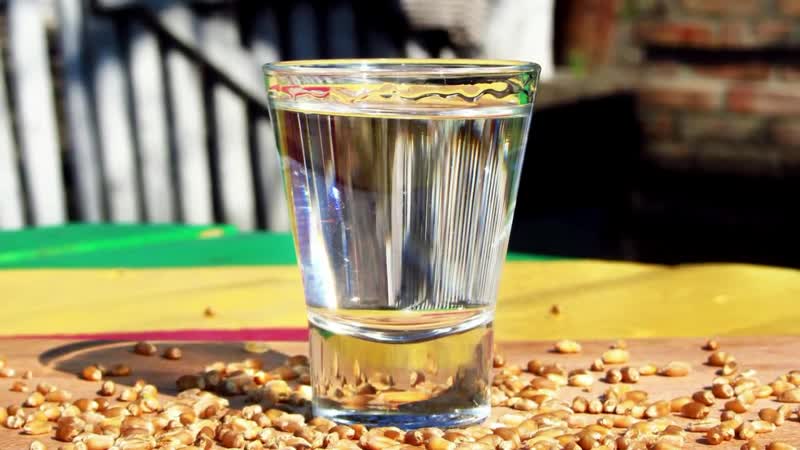
To speed up the process and reduce labor intensity, rye moonshine is prepared using sugar instead of malt. Fermentation is activated by “wild” yeast from the surface of the grain.
Unmalted rye mash
For mash, leaven is made from unmalted rye: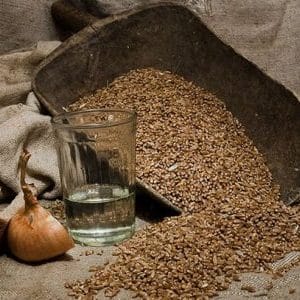
- prepare syrup from 0.6 kg of sugar and 3 liters of water;
- 3 kg of washed rye is poured into an enamel or glass container and filled with syrup;
- leave in a warm place for 3-4 days.
The starter is used for further preparation of mash, when carbon dioxide begins to be released and a characteristic sour smell appears.
The mash is placed like this:
- dissolve 2.4 kg of sugar in 12 liters of water;
- the resulting liquid is poured into a fermentation vessel and the starter is added;
- leave in a dark, warm place to ferment.
From the fermented wort, double distillation produces rye moonshine with a rich taste and aroma.
Read also:
How to germinate barley at home and what it is needed for.
How tasty and unusual it is to prepare pink tomatoes for the winter.
Step-by-step technology for growing zucchini in a greenhouse.
Conclusion
Rye moonshine is a drink with a distinctive taste and aroma. Even a novice moonshiner can prepare it at home. The main thing is to strictly follow the technology: properly prepare the ferment and malt, saccharify the rye starch, and create optimal conditions for fermentation.
Double distillation with the removal of harmful impurities will allow you to obtain a pleasant, high-quality product.
Rye moonshine infused in an oak barrel or on oak chips turns into excellent whiskey. You should definitely try making this kind of alcohol at home: the labor and time spent will be repaid with the pleasure of drinking a quality drink in pleasant company.